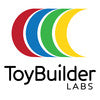A few week ago, the Up! printer at Los Angeles Makerspace had been down with a jammed extruder. Eain first reported that the extruder was stuttering while extruding - and tried to soak the nozzle in acetone to clear the nozzle. Unfortunately, that wasn't enough to clear the nozzle, and the subsequent jamming was so bad that the filament would neither feed nor unload from the extruder.
Here's the blow-by-blow on how I cleared the extruder. Hopefully, this will be useful for Up! as well as Makerbot and other FDM/FFF printers (pretty much all RepRap printers).
I ran the Up!'s unload and load process to confirm that the extruder was jammed. It was.

Next, I took the components off the extruder assembly.
I then ran the unload command to heat up the nozzle. I saw that the powder blue ABS had a half-moon bite taken out of it by the drive gear (because the filament was stuck). Moreover, a bit of melted ABS had smeared out where the filament enters the hot end. I think that may have contributed to it being a little harder to pull the filament out, but the main problem was probably that the filament just wasn't being grabbed by the extruder gear anymore.
Using a piece of filament, I made sure that the nozzle was getting hot as expected -- it was. I then tried manually feed the filament into the hot end to see if melted plastic would come out the nozzle. It wouldn't. It was clear that there was some kind of blockage at the nozzle.
With the hot end still hot, I took a fine steel wire (music wire/piano wire/guitar string) and carefully inserted it at the tip of the nozzle to "floss" the inside of the nozzle. After the first few mm's, the wire met some resistance, so I carefully used pliers to push the wire through. (Be careful to push the wire through straight!)


Once the wire came out the other end, I stopped and started as I continued to "floss" the nozzle in the upward direction. This allowed more of the plastic to stick to the wire and get pulled out of the hot end. You can see in the close up of the "floss" that there are black debris that came up with the plastic.

After that single flossing pass, I fed the filament in again from the top. This time, the plastic extruded easily. However, I did notice that it smoked/steamed a little. There is a reason for this -- the standard ABS that we sell works great on MakerBot's, Bukobot's, other RepRap printers, and pretty much all other FDM/FFF 3D printers. They all typically run the extruder at around 220 to 240 degrees. The Up! is a notable exception to this -- it operates the extruder at 260 degrees, which is way too hot for standard ABS. Normally, you have to buy your plastic from Up!, although you could also hack the printer to trick it into running the extruder at a cooler temperature.
Fortunately, I had previously given LAM a roll of our HIPS plastic (which we had previously called "ABSM"). This plastic can operate at the higher temperature of the Up! printer. I manually fed in that plastic, and it extruded easily and did not smoke.
Happy that the nozzle was clear, I removed the filament, reassembled everything, reloaded the extruder, and verified that the extruder was working well. It extruded well!
I then ran a print job and and immediately heard a clunk-clunk-clunk which at first sounded like a stuck extruder. But it was the wrong sound intensity and I could see plastic was still coming out. I then saw that the nozzle was hitting the perforated print bed.
I restarted a print after adjusting the nozzle height parameter in the Up! software. I then noticed that one side was higher than the others. The Up! has bed adjusting screws underneath the bed, so I adjusted those as well. I was then able to get a proper print started.
The print job ran fine. The ABSM/HIPS plastic is still a bit meltier than Up!'s special-formulation plastic, so the raft was still a challenge to remove. Still, the Qtechknow mascot came out great.
The raft did not stick well toward the back of the print bed, most likely because I didn't level the bed well enough (I only did a quick adjustment to get that first print run to start).
NOTE: Updated 9-2-13 to reflect the availability of HIPS filament.
